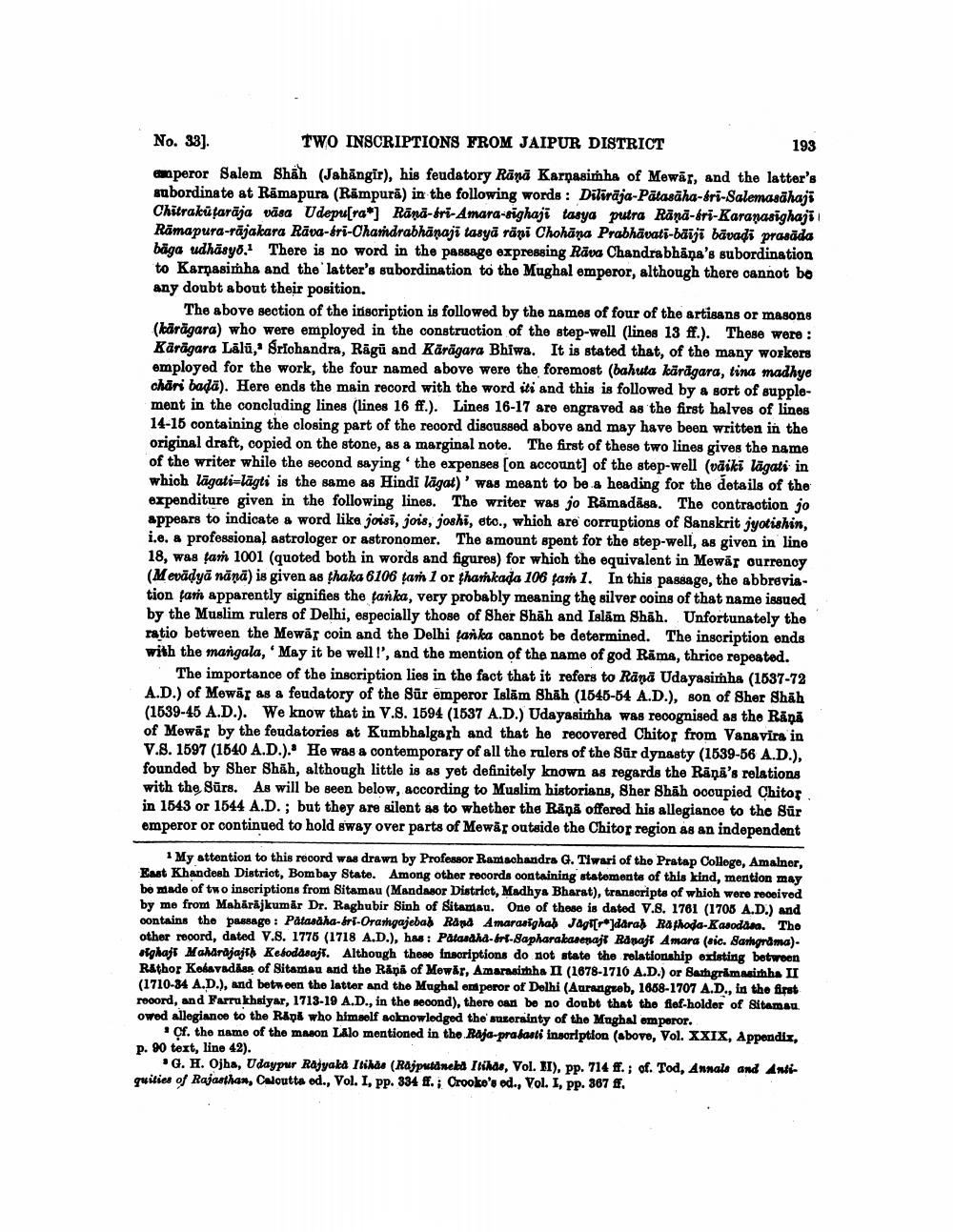________________
No. 38). TWO INSCRIPTIONS FROM JAIPUR DISTRICT
193 ena peror Salem Shah (Jahāngir), his feudatory Rāṇā Karnasimha of Mewar, and the latter's subordinate at Ramapura (Rampură) in the following words : Dilirāja-Pātasäha-tri-Salemasāhaji Chitrakūtarāja vāsa Udepu[ra] Rānā-tri-Amara-sighaji tasya putra Rāna-&ri-Karanasighaji Rāmapura-rājakara Rāva-fri-Chaṁdrabhānaji tasyā rāni Chohāna Prabhāvati-baiji bavadi prasāda bäga udhāsyo. There is no word in the passage expressing Rāva Chandrabhāņa's subordination to Karnasimha and the latter's subordination to the Mughal emperor, although there cannot be any doubt about their position.
The above section of the inscription is followed by the names of four of the artisans or masons (kärāgara) who were employed in the construction of the step-well (lines 13 ff.). These were : Kārāgara Lālā,» Srichandra, Rāgū and Kärāgara Bhiwa. It is stated that, of the many workers employed for the work, the four named above were the foremost (bahuta kärāgara, tina madhye chari bada). Here ends the main record with the word iti and this is followed by a sort of supplemont in the concluding lines (lines 16 ff.). Lines 16-17 are engraved as the first halves of lines 14-15 containing the closing part of the record discussed above and may have been written in the original draft, copied on the stone, as a marginal note. The first of these two lines gives the name of the writer while the second saying the expenses (on account] of the step-well (väikī lāgati in which lāgati-lāgti is the same as Hindi lagat)' was meant to be a heading for the details of the expenditure given in the following lines. The writer was jo Rāmadise. The contraction jo appears to indicate a word like joisi, jois, joshi, sto., which are corruptions of Sanskrit jyotishin, i.e. a professional astrologer or astronomer. The amount spent for the step-well, as given in line 18, was fan 1001 (quoted both in words and figures) for which the equivalent in Mewar currency (Mevädyā nāņā) is given as thaka 6106 tam 1 or tharkada 106 fan 1. In this passage, the abbreviation tam apparently signifies the tanka, very probably meaning the silver coins of that name issued by the Muslim rulers of Delhi, especially those of Sher Shāh and Islām Shāh. Unfortunately the ratio between the Mewar coin and the Delhi tarka cannot be determined. The inscription ends with the mangala, 'May it be well !', and the mention of the name of god Rāms, thrice repeated.
The importance of the inscription lies in the fact that it refers to Rana Udayasimha (1837-72 A.D.) of Mewăr as a feudatory of the Sur emperor Islām Shāh (1545-64 A.D.), son of Sher Shāh (1639-45 A.D.). We know that in V.8. 1594 (1537 A.D.) Udayasimha was recognised as the Rānā of Mewar by the feudatories at Kumbhalgarh and that he recovered Chitor from Vanavira in V.8. 1597 (1640 A.D.). He was a contemporary of all the rulers of the Sür dynasty (1539-56 A.D.), founded by Sher Shāh, although little is as yet definitely known as regards the Rāņi's relations with the Sūrs. As will be seen below, according to Muslim historians, Sher Shāh occupied Chitor. in 1543 or 1544 A.D.; but they are silent as to whether the Råņā offered his allegiance to the Sür emperor or continued to hold sway over parts of Mewar outside the Chitor region as an independent
1 My attention to this record was drawn by Professor Ramachandra G. Tiwari of tho Pratap College, Amalner, East Khandesh District, Bombay State. Among other records oontaining statements of this kind, mention may be made of two inscriptions from Sitamau (Mandasor District, Madhya Bharat), transcripts of which were received by me from Maharajkumar Dr. Raghubir Sinh of Sitanau. One of these is dated V.8. 1761 (1705 A.D.) and contains the passage : Patasha-ri-Orangajebab Rand Amarasighal Jagi[r]darah Rathoda Kasodana. Tho other record, dated V.8. 1776 (1718 A.D.), has: Pataadha-Art-Sapharakavenaji Ranajt Amara (sic. Sangrama). oghaji Maharajajil Keboddsaji. Although these inscriptions do not state the relationship existing between Rathor Kohavadise of Sitamau and the Rank of Mewar, Amarasimha II (1678-1710 A.D.) or Sathgrimasimha II (1710-84 A.D.), and between the latter and the Mughal en peror of Delhi (Aurangreb, 1868-1707 A.D., in the first record, and Farrukhaiyar, 1713-19 A.D., in the second), there can be no doubt that the flof-holder of Sitamsu. owed allegiance to the Rapi who himself acknowledged the suzorainty of the Mughal emperor.
Çf. the name of the mason Lalo mentioned in the Raja-prasasti inscription (above, Vol. XXIX, Appendix, p. 90 text, line 42).
'G. H. Ojha, Udaypur Rajyaka Itihão (Rajputinel Itihde, Vol. II), pp. 714 ff.; of. Tod, Annals and Antiquities of Rajasthan, Caloutta ed., Vol. I, pp. 334 ff.; Crooke's ed., Vol. I, pp. 387 ff.




